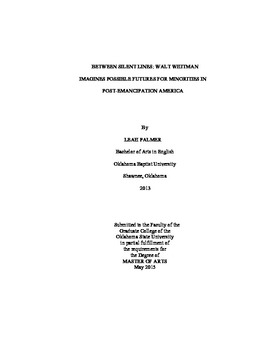| dc.contributor.advisor | Decker, William | |
| dc.contributor.author | Palmer, Leah Ashley | |
| dc.date.accessioned | 2016-09-29T18:36:22Z | |
| dc.date.available | 2016-09-29T18:36:22Z | |
| dc.date.issued | 2015-05-01 | |
| dc.identifier.uri | https://hdl.handle.net/11244/45197 | |
| dc.description.abstract | �Between Silent Lines� investigates the degree to which Walt Whitman�s poetic catalogues of American culture are influenced by contemporaneous nineteenth century theories, which aimed to imagine the future of minority races in America. This essay specifically examines the Vanishing Indian theory, Darwin�s evolutionary theory, as well as Abolitionist theories. I focus primarily on Section 7 of �I Sing the Body Electric,� in which Whitman interrogates the limbs of a black man at auction. Using excerpts from Whitman�s notebooks and published revisions of Leaves of Grass, I show that Whitman is susceptible to subscribing to dominant contemporaneous theories about race, and the poet conflates these theories in his representations of African Americans on the auction block. Because he lived through the antebellum period as well as the Civil War, Whitman�s poetry reveals a concern for the future of a country that is at odds with regards to the civil rights of African Americans. Whitman asserts that minority races in America would inevitably and sadly be eliminated from the country, as they are unable to withstand the force of Manifest Destiny and the rise of an American republic. However, Whitman�s notion is at conflict with his promotion of abolition and the equality of all men, regardless of race. Therefore, Section 7 expresses hope for the equality of all men while it simultaneously despairs the black man�s future in America. Still Whitman imagines that equality between the dominant white race and minorities is contentment on biological evolution�losing blackness by degree and assimilating to white culture and its definitions of progress. My essay aims to explore Whitman�s solution to the contemporaneous black problem, which rests in the poet�s hope for physical and societal progress among blacks. | |
| dc.format | application/pdf | |
| dc.language | en_US | |
| dc.rights | Copyright is held by the author who has granted the Oklahoma State University Library the non-exclusive right to share this material in its institutional repository. Contact Digital Library Services at lib-dls@okstate.edu or 405-744-9161 for the permission policy on the use, reproduction or distribution of this material. | |
| dc.title | Between Silent Lines: Walt Whitman Imagines Possible Futures for Minorities in Post-emancipation America | |
| dc.type | text | |
| dc.contributor.committeeMember | Frohock, Richard | |
| dc.contributor.committeeMember | Eldevik, Randi | |
| osu.filename | Palmer_okstate_0664M_14025.pdf | |
| osu.accesstype | Open Access | |
| dc.description.department | English | |
| dc.type.genre | Thesis | |
